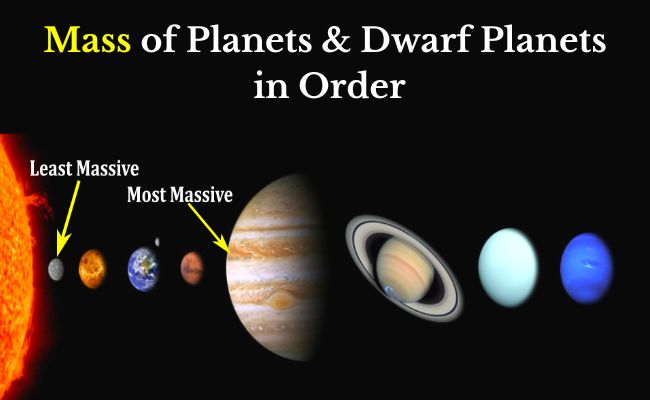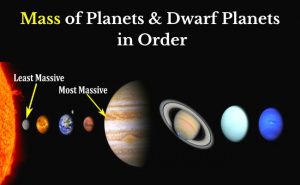The planets of our solar system have different sizes and different masses. Here in this article, you will know the Mass of Planets in Order, the Heaviest Planet of Solar System, and the Lightest Planet of Solar System.
The mass of a planet depends on its size and density. All planets are different in mass as their sizes are different and the densities of planets are different.
There are two types of planets in our solar system, 1. Terrestrial planets, 2. Gaseous planets.
- Terrestrial planets are small in size but their density is higher. They are rocky planets, made of silicate rocks and metals. Due to their higher density per cubic meter, the mass of terrestrial planets is more.
- Whereas, gaseous planets are very large in size but have lower densities. They are mostly made of gases. Due to their lower density per cubic meter, the mass of gaseous planets is comparatively lower.
So, ultimately all planets have different masses. Mercury is the least massive and Jupiter is the most massive planet. And below you will know, the planets in order of mass in kilogram and pound unit.
Mass of All Planets in Order
Of all 8 planets, Mercury is the lightest planet in the solar system, whereas Jupiter is the heaviest planet. Though Jupiter is a gaseous type planet, still it is the heaviest! This is because, the size of planet Jupiter is just too much, to neglect the lower density.
The mass of the planets in order are Mercury, Mars, Venus, Earth, Uranus, Neptune, Saturn, and Jupiter. These masses of all planets are in order from lightest to heaviest. Mercury is the least massive planet in our solar system, and Jupiter is the most massive planet in our solar system.
Below you will see the Planets in Order of Mass including Pluto and other dwarf planets, the Sun, and the Moon.
The mass of planets in order is given in two units, kilogram (kg) and pound (lb).
| Mass of Mercury | 3.30×1023 kg (7.27×1023 lbs) |
| Planet Mercury is the closest to the sun and it is also the lightest planet in our solar system. This planet is just a little heavier than our moon. | |
| Mass of Mars | 6.41×1023 kg (1.41×1024 lbs) |
| The red planet Mars is the second lightest planet in our solar system. | |
| Mass of Venus | 4.86×1024 kg (1.07×1025 lbs) |
| Venus is the 3rd least massive planet of our solar system. | |
| Mass of Earth | 5.97×1024 kg (1.31×1025 lbs) |
| Earth is the 4th planet in order of mass from light to heavy. | |
| Mass of Uranus | 8.68×1025 kg (1.91×1026 lbs) |
| Uranus is the 5th planet in order of mass from light to heavy. Planet Uranus is larger than Neptune. Still, it has a lower mass, it is because the density of the planet Uranus is lower than Neptune. | |
| Mass of Neptune | 1.02×1026 kg (2.25×1026 lbs) |
| Neptune is the 6th massive planet from light to heavy scale. | |
| Mass of Saturn | 5.68×1026 kg (1.25×1027 lbs) |
| Saturn is the 2nd heaviest planet in our solar system. | |
| Mass of Jupiter | 1.89×1027 kg (4.17×1027 lbs) |
| Jupiter is the heaviest planet in our solar system. | |
So, these were the mass of planets in order from lightest to heaviest. 1st one Mercury is the lightest planet and the 8th one Jupiter is the heaviest planet, according to the order of mass. And the second heaviest planet is Saturn, whereas the second lightest planet is Mars.
Mass of All 5 Dwarf Planets in Order
Below are the mass of 5 dwarf planets in order. These are the IAU (International Astronomical Union) recognized dwarf planets only.
| Mass of Ceres | 9.3 × 1020 kg (2.05×1021 lbs) |
| Dwarf planet Ceres is the lightest dwarf planet. | |
| Mass of Makemake | 3.0 × 1021 kg (6.61×1021 lbs) |
| In order of mass from lightest to heaviest, Makemake is the 2nd dwarf planet. | |
| Mass of Haumea | 4.0 × 1021 kg (8.82×1021 lbs) |
| Haumea is the 3rd dwarf planet in order of mass from light to heavy. | |
| Mass of Pluto | 1.3 × 1022 kg (2.87×1022 lbs) |
| Pluto is the 4th dwarf planet in mass from light to heavy and the 2nd dwarf planet from heavy to light scale. Though it is larger than Eris, still due to low density it has a lower mass. | |
| Mass of Eris | 1.65 × 1022 kg (3.63×1022 lbs) |
| Eris is the heaviest dwarf planet in our solar system. | |
Mass of Sun and Moon
Below are the mass of the Sun and the mass of the Moon. Their given mass is in two units, kilograms (kg), and pounds (lb).
| Mass of Sun | 2.0 × 1030 kg (4.41×1030 lbs) |
| The Sun is a star and it is the largest and heaviest object of our solar system. | |
| Mass of Moon | 7.3 × 1022 kg (1.61×1023 lbs) |
| Moon is the earth’s only natural satellite. The mass of the moon is just a little shorter than planet Mercury. | |
Here in this article, you got to know the planets in order of mass from lightest to heaviest. So, Jupiter is the heaviest planet in the solar system and Mercury is the lightest planet.
And you also got to know, the dwarf planet in order of mass and the mass of the sun and the mass of the moon.
- Check the Best Children’s Science Book for kids of all ages…
Related Posts from Planets Education:-
- Size of Planets in Order from Smallest to Largest
- Closest and Farthest Distance of Planets from Sun
- Sun Distance from Earth (km, miles, and light-years)
- 5 Best Solar System Backpacks in 2024
- Mass of Planets in Order from Lightest to Heaviest
- Star Projector {2024}: Star Night Light Projector



